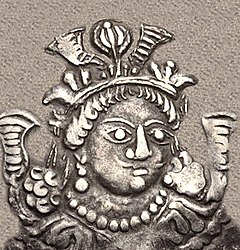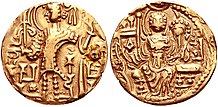Kidara I
| Kidara | |
|---|---|
 Portrait of Kidarite king Kidara I, circa 350-386 CE.[1] He wears his characteristic crown with ribbon flying upward. The use of the 3/4 portrait is sometimes attributed to the influence of the coinage of Byzantine ruler Arcadius (377–408 CE).[2] | |
| Kidarites | |
| Reign | c. 350–390 CE |
| Predecessor | Peroz |
| Successor | Uncertain |
Kidara I (Late Brahmi script: ![]()
![]()
![]() Ki-da-ra) fl. 350-390 CE) was the first major ruler of the Kidarite Kingdom, which replaced the Indo-Sasanians in northwestern India, in the areas of Kushanshahr, Gandhara, Kashmir and Punjab.[4]
Ki-da-ra) fl. 350-390 CE) was the first major ruler of the Kidarite Kingdom, which replaced the Indo-Sasanians in northwestern India, in the areas of Kushanshahr, Gandhara, Kashmir and Punjab.[4]
Reign[edit]
Kidara himself was a nomadic ruler who invaded the areas of Tukharistan and Gandhara hitherto ruled by the Indo-Sasanians. It is thought the Kidarites had initially invaded Sogdiana and Bactria from the north circa 300 CE.[5] His people may have been pushed out from the northern areas of Bactria by migrating Hephthalites.[4]
Kidara's ethnicity is unclear, but he may himself have been a Chionite, and he belongs to the general category of the Huns or Huna.[5] Already during the 4th century Sasanian Emperor Shapur II had fought against Chionite invaders led by king Grumbates, and ultimately passed an alliance with them, using their military in the campaign against the Romans in the siege of the fortress of Amida (now Diyarbakır, Turkey).[4] Chinese sources explain however that the Kidarites are the Lesser Yuezhi, which would make them relatives of the Yuezhi, themselves ancestors of the Kushans.[5]
Kidara having established himself in Tukharistan and Gandara, took the title of Kushanshah which until that time had been used by the rulers of the Indo-Sasanian kingdom.[4] He thus founded the eponymous new dynasty of the Kidarites in northwestern India.[5] The Kidarites also claimed to have been successors of the Kushans, possibly due to their ethnic proximity.[5]
Coinage[edit]
Kidara struck both Sasanian-style gold and silver coins (imitating his immediate predecessor in the region Varahran I) and Kushan-style gold coins, before issuing coins in his own name.[6][7]
- Coin in the name of Kushano-Sasanian Varahran I struck under Kidara circa CE 350-365. Crown with ribbon flying upward. Kidarite tamgha
 to the right. Balkh mint.
to the right. Balkh mint. - Coin in the name of Kidara, with legend "βαγο Κιδαρο οοζορκο κοþανοþαο" "Kidara, the great Kushanshah". Type 6A-D. Coin type found in Tepe Maranjan, dated to before 388 CE.[8]
- A coin of Kidara in the style of Indo-Sassanian ruler Bahram Kushanshah.[9] Crown with ribbon flying upward. Gandhara mint.
See also[edit]
References[edit]
- ^ CNG Coins
- ^ Lerner, Judith A. (210). Observations on the Typology and Style of Seals and Sealings from Bactria and the Indo-Iranian Borderlands, in Coins, Art and Chronology II. The First Millennium CE in the Indo-Iranian Borderlands. Vienna: ÖAW. p. 246, note 7.
- ^ Tandon, Pankaj (2009). "An Important New Copper Coin of Gadahara". Journal of the Oriental Numismatic Society (200): 19.
- ^ a b c d History of Civilizations of Central Asia, Ahmad Hasan Dani, B. A. Litvinsky, Unesco p.38 sq
- ^ a b c d e History of Civilizations of Central Asia, Ahmad Hasan Dani, B. A. Litvinsky, Unesco p.119 sq
- ^ Sayles, Wayne G. (1999). Ancient Coin Collecting VI: Non-Classical Cultures. Iola, WI: Krause. p. 79. ISBN 0-87341-753-4.
- ^ Cribb, Joe (2010). "The Kidarites, the numismatic evidence" (PDF). Coins, Art and Chronology. Vol. 2 : The first millennium C.E. in the Indo-Iranian borderlands. Vienna: Verlag der Österreichischen Akademie der Wissenschaften. pp. 91–146. ISBN 978-3-7001-6885-0.
- ^ Bakker, Hans T. (2017). The Huns in Central and South Asia. How Two Centuries of War against Nomadic Invaders from the Steps are Concluded by a Game of Chess between the Kings of India and Iran.
- ^ "Kushano-Sasanian Kings of India. "Bahram" (Kidara)". CNG Coins.


 French
French Deutsch
Deutsch


![Coin in the name of Kidara, with legend "βαγο Κιδαρο οοζορκο κοþανοþαο" "Kidara, the great Kushanshah". Type 6A-D. Coin type found in Tepe Maranjan, dated to before 388 CE.[8]](http://upload.wikimedia.org/wikipedia/commons/thumb/4/41/Kidara_coin%2C_4th_century_CE%2C_type_6A-D.jpg/200px-Kidara_coin%2C_4th_century_CE%2C_type_6A-D.jpg)
![A coin of Kidara in the style of Indo-Sassanian ruler Bahram Kushanshah.[9] Crown with ribbon flying upward. Gandhara mint.](http://upload.wikimedia.org/wikipedia/commons/thumb/f/f7/Kidarites_ruler_Kidara_circa_350-385_CE_in_Sasanian_style.jpg/200px-Kidarites_ruler_Kidara_circa_350-385_CE_in_Sasanian_style.jpg)
